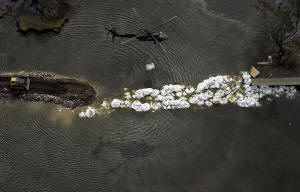New Orleans marks 20th anniversary of Hurricane Katrina with memorials
and brass band parade
[August 29, 2025]
By JACK BROOK
NEW ORLEANS (AP) — Twenty years after Hurricane Katrina crashed into the
Gulf Coast, New Orleans is set to commemorate the anniversary Friday
with memorials, performances and a parade to honor those who were
affected.
Katrina, which was a Category 3 hurricane when it made landfall in
southeast Louisiana on Aug. 29, 2005, remains the costliest U.S. storm
on record, with damage estimated at upward of $200 billion when adjusted
for inflation, according to the National Oceanic and Atmospheric
Administration. About 1,400 people died in five states.
The failure of the federal levee system inundated about 80% of the city
in floodwaters that took weeks to drain. Thousands of people clung to
rooftops to survive or waited for evacuation in the sweltering,
under-provisioned Superdome stadium.
Survivors and city leaders are set to gather in the Lower Ninth Ward, a
predominantly Black community where a levee breach led to devastating
flooding that was exacerbated by a delayed government response.
The event, sponsored by Katrina Commemoration Inc. and Hip Hop Caucus,
will feature prayers and prominent local artists like Dawn Richard and
Mia X. Organizers say it is also intended to draw attention to the
sinking city’s poor infrastructure, gentrification and vulnerability to
climate change.

Thousands of attendees are expected to join a brass band parade known as
a second line. The beloved New Orleans tradition has its roots in
African American jazz funerals, in which grieving family members march
with the deceased alongside a band and trailed by a second line of
dancing friends and bystanders.
A parade has been staged on every Katrina anniversary since local
artists organized it in 2006 to help neighbors heal and unite the
community.
“Second line allows everybody to come together,” said the Rev. Lennox
Yearwood, president of Hip Hop Caucus. “We’re still here, and despite
the storm, people have been strong and very powerful and have come
together each and every year to continue to be there for one another.”
Other commemorations include a wreath-laying ceremony at a memorial for
dozens of unidentified storm victims and a minute of silence, to be
observed at 11:20 a.m.
[to top of second column]
|

A military helicopter drops a sandbag as work continues to repair
the 17th Street canal levee in New Orleans, Sept. 5, 2005. (AP
Photo/David J. Phillip, Pool, File)

There are also museum exhibitions, documentary screenings and
city-organized discussions Saturday on the future of New Orleans'
culture, infrastructure and ongoing recovery.
City leaders are pushing for the anniversary to become a state
holiday.
Katrina's impact still felt
The city's population, nearly half a million before Katrina, is now
384,000 after displaced New Orleanians scattered across the nation.
Many ended up in Atlanta, Dallas and Houston.
In the aftermath, the levee system was rebuilt, public schools were
privatized, most public housing projects were demolished and a
hospital was shuttered. About 134,000 housing units were damaged by
Katrina, according to The Data Center, a nonprofit research agency.
The storm had a disproportionate impact on the city's Black
residents. While New Orleans remains a majority Black city, tens of
thousands of Black residents were unable to return after Katrina. A
botched and racially biased federal loan program for home
rebuilding, coupled with a shortage of affordable housing, have made
it harder for former residents to come back.
“(Katrina) wasn't just a New Orleans moment,” Yearwood said. “It was
a national moment, and it's a time for reflection and commitment to
a better way of how we're handling these issues moving forward.”
___
Brook is a corps member for The Associated Press/Report for America
Statehouse News Initiative.
All contents © copyright 2025 Associated Press. All rights reserved
 |